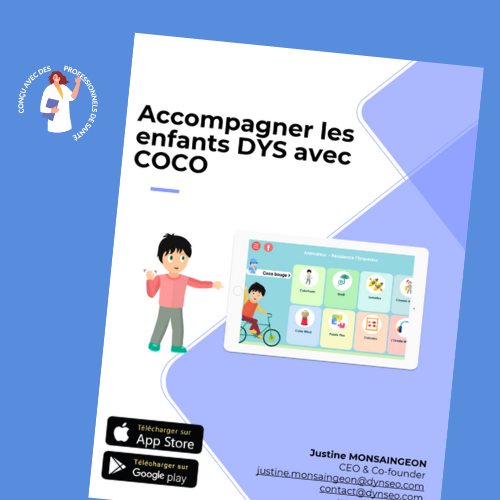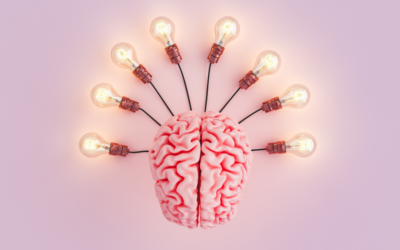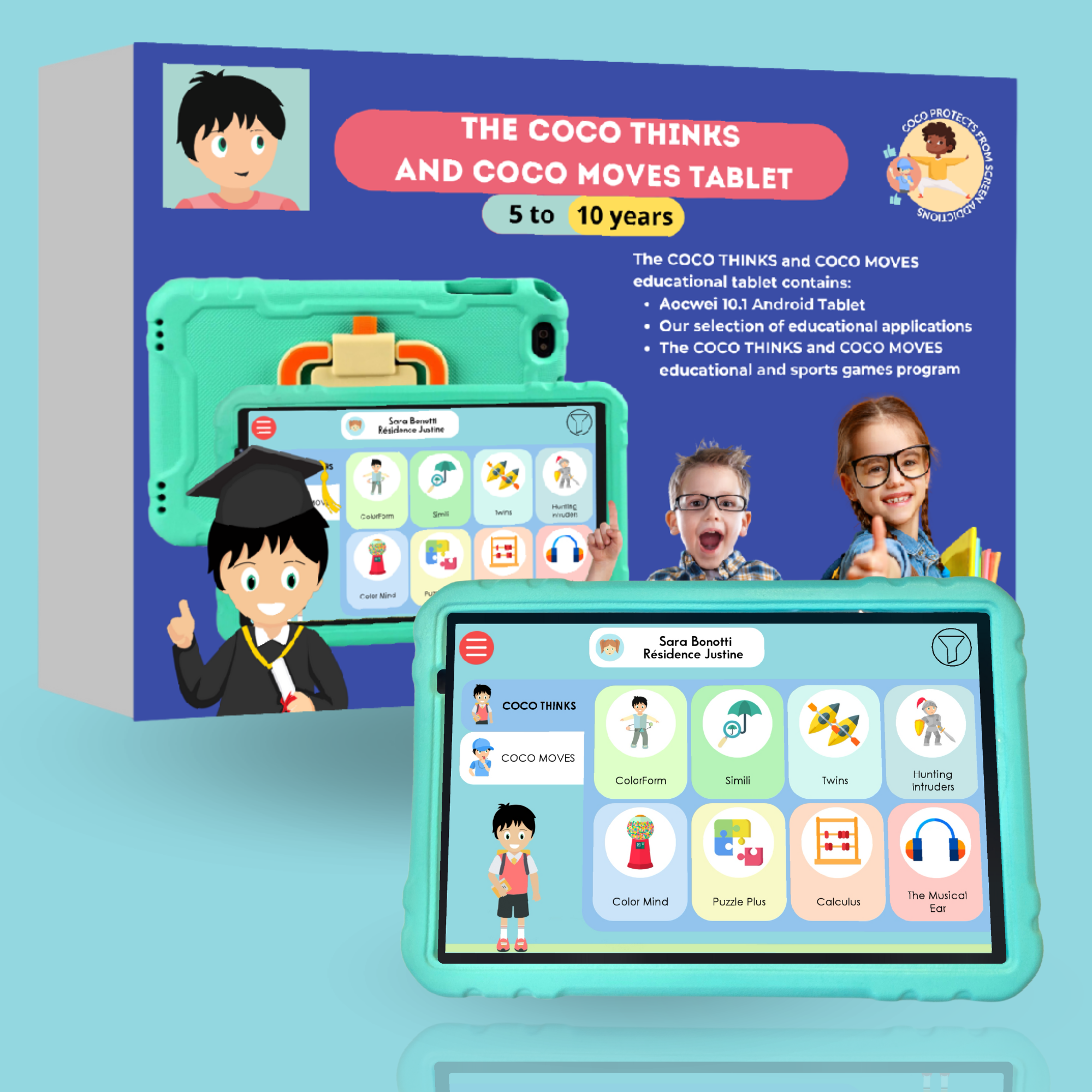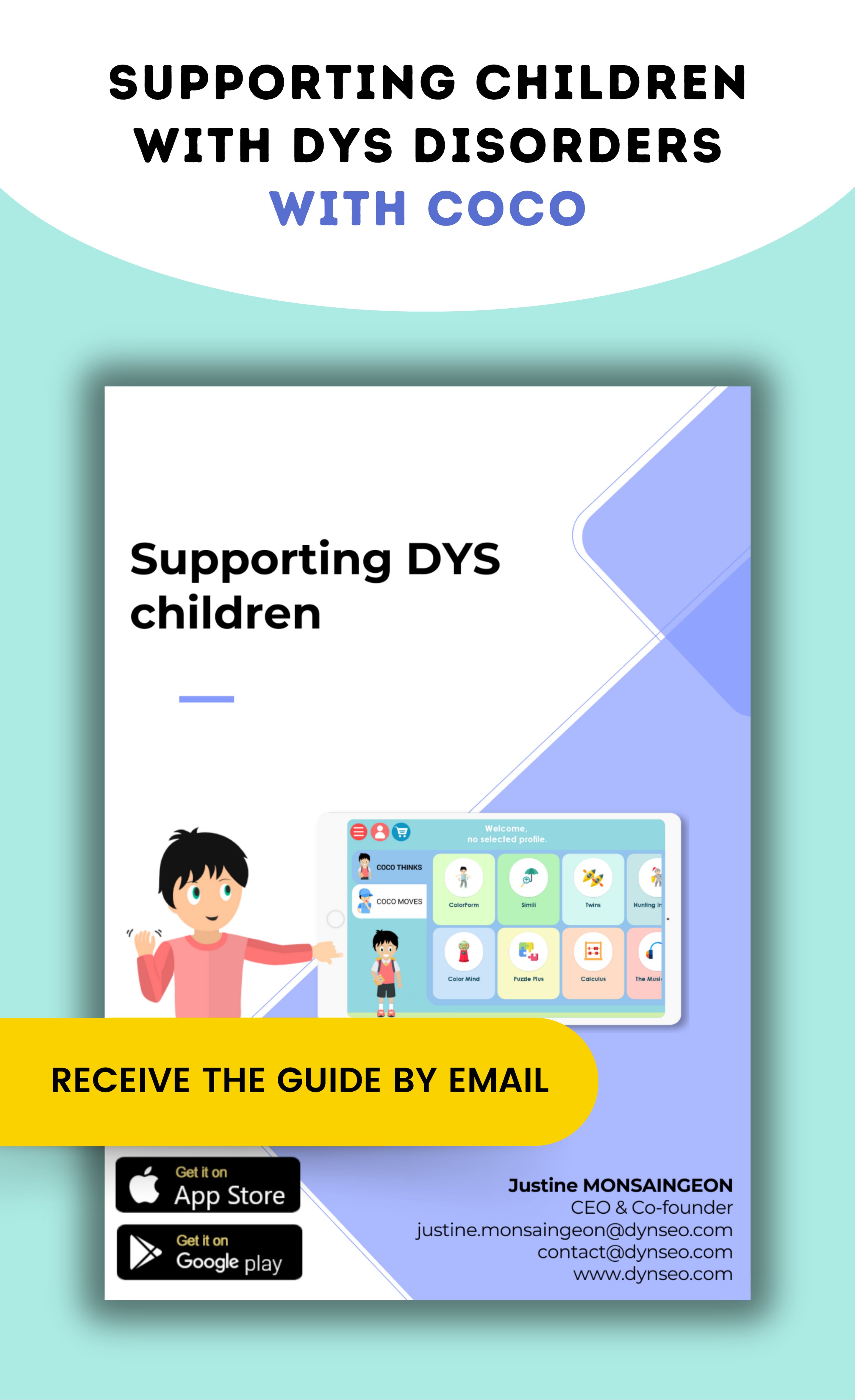Children with DYS disorders face many challenges in their educational journey. They may have difficulty reading and writing, following verbal instructions or concentrating for long periods. These difficulties can lead to low self-esteem and frustration for the child.
It is therefore crucial to use effective teaching strategies to support these children in their learning. These strategies must be tailored to each child’s individual needs, taking into account their strengths and weaknesses. They must also be flexible, allowing children to progress at their own pace.
Using technology to support children with DYS disorders
The incorporation of technology in the support of children with DYS disorders has become common practice, offering innovative solutions to overcome learning challenges. A remarkable example of this integration is the “Coco” educational program, specially designed to support DYS children in their educational journey.
Coco: An Innovative Educational Program
Coco is an educational program that uses the latest technological advances to create an adaptive and interactive learning environment. This program is designed to adapt to the specific needs of children with DYS disorders, offering a personalized approach that takes into account their strengths and challenges.
Advantages of Coco and similar technologies
- Personalization: Coco adjusts the difficulty level of activities according to the child’s responses, ensuring a tailor-made learning experience that progresses at the student’s pace.
- Instant feedback: Instant feedback is essential for DYS children, enabling them to understand their mistakes in real time and learn more effectively. Coco provides this valuable feedback, encouraging perseverance and growth.
- Engagement and motivation: By making learning fun and interactive, Coco captures children’s attention and keeps their motivation high. Activities are designed to be both educational and entertaining, transforming learning challenges into opportunities for play and discovery.
- Visual and auditory support: Recognizing the reading and writing difficulties common among DYS children, Coco integrates visual and auditory aids to support learning, such as reading texts aloud and using colors and graphics to facilitate comprehension.
- Developing independence: Coco encourages children to take charge of their own learning, developing their independence and self-confidence. Children learn to set their own goals, monitor their progress and identify areas needing extra attention.
Integration into the Educational Pathway
Integrating Coco into the educational pathway of DYS children requires close collaboration between educators, parents and therapists. This partnership ensures that the program is used to best effect, complementing existing teaching strategies and providing consistent support at home and in the classroom.
Technology, through educational programs like Coco thinks and Coco moves, offers a promising avenue for supporting children with DYS disorders. By combining personalization, engagement, and multimodal support, these technological tools can transform the learning experience for DYS children, enabling them to overcome challenges and thrive academically. At DYNSEO, our experience with Coco and other similar technologies has reinforced our conviction that pedagogical innovation is key to helping these children succeed.
Multisensory teaching strategies for children with DYS disorders
Multisensory teaching is a pedagogical approach that uses several senses to facilitate learning. This approach is particularly beneficial for children with DYS disorders, as it enables them to use different sensory channels to process information.
The benefits of multisensory teaching for children with DYS disorders are numerous. It encourages the child’s active involvement in the learning process, reinforces comprehension and memorization, and enables him or her to use sensory strengths to compensate for weaknesses.
Various multisensory strategies can be used to support learning in children with DYS disorders. For example, the use of tactile manipulatives can help children with difficulties understanding abstract mathematical concepts. The use of colors and visual symbols can help children with reading and writing difficulties to organize their ideas.
Encouraging independent learning in children with DYS disorders
Independent learning is an essential aspect of skill development for children with DYS disorders. It enables them to take charge of their own learning, develop self-confidence and acquire self-regulation skills.
There are various strategies for encouraging independent learning in children with DYS disorders. For example, it’s important to give them choices and encourage them to make decisions about their learning. It is also important to provide them with adequate support, such as additional resources or individual coaching, to help them overcome any obstacles they may encounter.
Regular assessment to monitor the progress of children with DYS disorders
Regular assessment is essential to monitor the progress of children with DYS disorders. It enables us to measure their progress, identify areas where they need extra support, and adjust teaching strategies accordingly.
Different types of assessment can be used to monitor the progress of children with DYS disorders. For example, formal assessments, such as standardized tests, can be used to measure a child’s academic skills. Informal assessments, such as observations and interviews, can also be used to gather information about the child’s behavior and needs.
Working with parents and healthcare professionals to support children with DYS disorders

Collaboration with parents and healthcare professionals is essential to support children with DYS disorders. Parents are their children’s first educators and play a key role in their child’s development. Health professionals, such as speech therapists and psychologists, can provide specialized support and advice to parents and teachers.
There are many advantages to working with parents and healthcare professionals. It enables us to establish open, regular communication, share information about the child and his or her needs, and work together to implement effective teaching strategies.
Creating an inclusive learning environment for children with DYS disorders
Creating an inclusive learning environment is key to supporting children with DYS disorders. An inclusive environment recognizes and values the diversity of learners and offers equal opportunities to all.
The benefits of an inclusive learning environment for children with DYS disorders are numerous. It encourages their active participation, boosts their self-esteem and sense of belonging, and promotes their academic success.
Different strategies can be used to create an inclusive learning environment. For example, it’s important to provide individualized support for children with DYS disorders, such as task adaptations or additional resources. It’s also important to make other students aware of the diversity of learners and to promote social inclusion.
Use of visual aids to help children with DYS disorders understand the material
The use of visual aids is an effective teaching strategy for children with DYS disorders, such as dyslexia, dyspraxia, dyscalculia and dysphasia. These tools harness the learner’s visual strength to overcome difficulties with reading, writing, arithmetic or verbal expression. Here’s how to enrich this approach:
Visual Media Types
- Infographics: These combine text and images to explain complex subjects clearly and concisely. They are particularly useful for summarizing lessons or presenting data.
- Mind maps: These help visualize the links between different ideas or concepts, facilitating overall understanding of a subject and stimulating memory.
- Comparative tables: These help to compare and contrast information, making differences and similarities clearer.
- Visual timelines: useful for historical subjects, they enable you to visualize the order of events and their interrelationships over time.
- Educational videos: Videos that explain concepts through captivating animations and visuals can greatly enhance understanding.
Strategies for using visual media
- Personalization: Adapting visual aids to the child’s interests and level of understanding can increase their effectiveness. Including elements that capture the child’s attention can also encourage engagement.
- Interaction: Encourage children to create their own visual aids as an integral part of their learning process. This can reinforce their understanding and retention of information.
- Multisensory integration: Combining visual supports with auditory and kinaesthetic approaches can optimize learning by engaging several senses.
Benefits of Visual Supports
- Reduced anxiety: The clarity provided by visual aids can reduce the anxiety associated with understanding new concepts or performing complex tasks.
- Learner autonomy: Visual aids enable children to progress at their own pace, returning to information as many times as necessary for deep understanding.
- Improved self-confidence: By facilitating comprehension, visual aids help to boost children’s confidence in their learning abilities.
Visual aids represent a fundamental pillar in the education of children with DYS disorders, offering an enriching alternative to traditional teaching methods. Their judicious implementation can transform the educational experience of these children, enabling them to fully exploit their learning potential while effectively navigating their specific challenges.
Adapting tasks to meet the individual needs of children with DYS disorders
It is essential to adapt tasks to meet the individual needs of children with DYS disorders. Every child is unique and has different strengths and weaknesses, so it’s important to take these differences into account when planning learning activities.
Different strategies can be used to adapt tasks to the individual needs of children with DYS disorders. For example, you can provide clear, concise instructions, divide tasks into smaller, more manageable steps, or use visual aids to aid understanding.
Thus, children with DYS disorders need effective teaching strategies to succeed academically. The use of technology, multisensory teaching, encouraging independent learning, regular assessment, collaboration with parents and healthcare professionals, creating an inclusive learning environment, using visual aids and adapting tasks are all strategies that can be used to support these children in their learning. It’s important to recognize that every child is unique and has individual needs, so it’s essential to tailor strategies accordingly.
AND FOR MORE INFORMATION
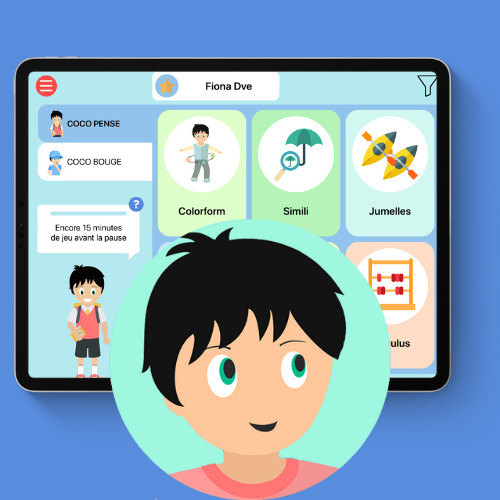
COCO, CHILDREN’S GAMES DYS
Coco pense et Coco bouge is an educational games program for dyslexic, dyspraxic, dysphasic and dyscalculic children aged 5 to 10. A variety of games to work on all cognitive functions. 15 minutes of screen time = 1 sports break
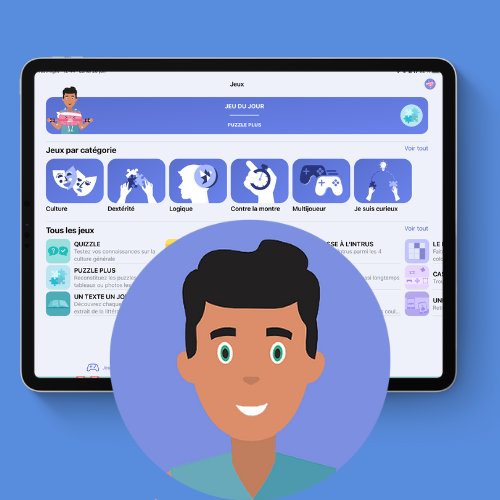
JOE, FOR DYSLEXIC ADULTS
The JOE program, your brain coach, will be able to support dysfunctional teenagers and adults. They can search for games by cognitive function. Joe will also be able to recommend the games best suited to each user’s needs. Smartphone and tablet.

THE MARBLE THAT ROLLS FOR ATTENTION
The Bille qui Roule application is an innovative tool designed to work on attention and concentration through fun games. The tabletop is used as a pendulum to perform the exercises. For example, you have to follow the ball and keep it in a circle, etc.
Other articles that might interest you:
Fine Motor Techniques: Games and Exercises for Children with Dyspraxia.
Dyspraxia, also known as developmental coordination disorder, is a neurological disorder that affects the planning and...
The Role of Audio Books in the Learning of Dyslexic Children.
Dyslexic children face many difficulties when it comes to reading. The first problem they face is decoding, i.e. the...
Supporting children with autism
Dynseo proposesSUPPORTING CHILDREN WITH AUTISM with COCO THINKS AND COCO MOVESDynseo and its team are very much...


